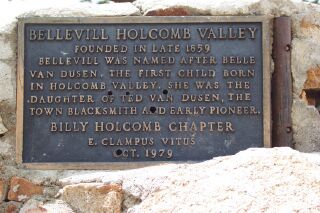Belleville

|
It all started when William
F. Holcomb left Indiana and made the overland trip to seek his fortune in
the mining camps of Northern California. Discouraged by his poor luck, he
drifted southward. There he was told a story about a small gold discovery
in the San Bernardino Mountains, and so in 1859, Bill Holcomb left Los
Angeles and came to Starvation Flats. |
 |
East
of the original discovery was a rich flat which drew the largest gathering
of prospectors. A town soon sprang up. In addition to the many saloons,
there was one store, two butcher shops, two laundries, one bakery, three
carpenter shops, two blacksmiths, one stamp mill, and one sawmill. On the
outskirts "dugouts" and hastily built shacks were used as
shelter for the miners. The population was the typical mining town
variety, good men and industrious workers, worthless characters and
professional "badmen." The blacksmith's wife, Mrs. Jed Van Dusen,
made a flag from petticoats for the town's first July 4th celebration. For
her patriotic efforts the town was named Belleville in honor of her pretty
little daughter, Belle. |
 |
Well.. I couldn't
resist. After all I can just picture Karen back in the gold rush days
tending to the cabin while I was out busting my but looking for gold..
Well. maybe she would be working in the Saloon.. Hmmmm |
 |
Just
beyond the Belleville Cabin, remains of several "arrastres" may
be seen. Although they are of more recent construction than those of the
1860's, they serve to illustrate the method then used for extracting gold
from the ore.
The early
types consisted of a low stone and dirt wall built around a large and
fairly level stone. To a vertical post in the center was pivoted a long
horizontal beam. An end of the beam was harnessed to a donkey or mule to
provide the power necessary by walking in a circle outside the low
arrastre wall. A heavy chain was fastened to the beam about midway, and
the free end of the chain linked to a ring bolt wedged into a heavy
"drag stone." Occasionally two drag stones were used attached to
a cross member.
The slow
tedious process of grinding the chunks of ore took about four hours. Water
was used to wash the crushed ore out of a single opening in the arrastre
where the gold was separated from the sand, usually by sluice boxes. In
the early days of the gold rush, over 100 arrastres were built and used to
grind gold-bearing quartz.
|
|
|



